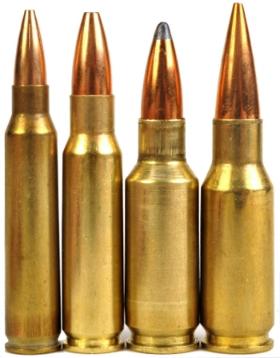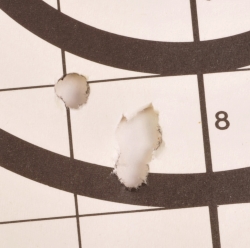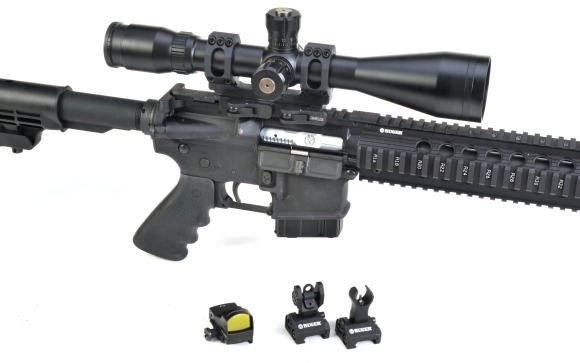
After handloading a hundred rounds of ammo, and shooting the SR-556 6.8 SPC for accuracy, data collection and handling, I ended up handloading a hundred rounds more as it is a tough gun to put down. If this gun has recoil, I wasn’t able to find it, even though the 6.8 Remington SPC provides significantly more power than the 5.6x45mm. I found myself comfortably and accurately shooting the SR-556 with metallic, optical and FastFire II dot sighting systems. Even when shooting what is rapid fire to me, 3 shots in 2.7 seconds, it was easy to keep the gun on target. I can honestly say that the SR-556 is a… nifty looking rifle, but the best part of the SR-556/6.8 happens when it is being fired. The Ruger SR-556 is an excellent execution of an AR derivative design. Ruger includes the right accessories and the adjustable gas/piston operating system is a feature contributes significantly to the firearm’s performance; heat reduction, cleaner operation, greater reliability, and recoil dampening.
 My specific interest in the 6.8 SPC version of the SR-556 is based on a preference for a cartridge of greater power than the standard 5.56x45mm. The more AR type guns are rebranded as modern sporting rifles, the more an alternative to the little 5.56 round is needed. i.e. If the cartridge won’t get it done on medium size game in hunting applications, there isn’t a great deal of value in extended magazines, Picatinny rails and rifle ergonomics made for military, police and security applications. With the 6.8 Remington SPC chamber, the SR-556 becomes much more than the Transformer like appeal of an AR 15. The hardware function and cartridge performance represent a perfect fit for many security and hunting applications.
My specific interest in the 6.8 SPC version of the SR-556 is based on a preference for a cartridge of greater power than the standard 5.56x45mm. The more AR type guns are rebranded as modern sporting rifles, the more an alternative to the little 5.56 round is needed. i.e. If the cartridge won’t get it done on medium size game in hunting applications, there isn’t a great deal of value in extended magazines, Picatinny rails and rifle ergonomics made for military, police and security applications. With the 6.8 Remington SPC chamber, the SR-556 becomes much more than the Transformer like appeal of an AR 15. The hardware function and cartridge performance represent a perfect fit for many security and hunting applications.
A verbal regurgitation, but required for the sake of context. The 6.8 Remington SPC originated as a 2003 cooperative effort with contributions from Steve Holland and Cris Murray from the 5th Special Forces Group of the United States Army, Remington and Hornady. The military spec’d the objective of enhance combat effectiveness of the M4 carbine, Remington designed a case based on a shortened version of their old 30 Remington that would work within M4 system parameters and Hornady produced a short ogive 115 grain bullet that would provide maximum performance with a 2.250″ maximum COL. The SAAMI COL spec is 2.260″, however, single shot and bolt action rifles are often loaded to a longer than specification 2.355″ COL. Yes, how much clarity would you like in your mud?
Go big… but not too big
There have been lots of successful attempts at boosting the performance of a 2.260″ cartridge without bumping pressure too high, increasing gas volume too much, or bumping bolt thrust. If a cartridge designer stays relatively close to home, it is relatively easy to end up with a reliably functioning AR. If the envelope is pushed too much, it’s like teaching a giraffe how to roller-skate. Not that I know from experience, but I have been know to create two AR 7½ from one AR 15 when applying a bit too much… exuberance during cartridge development. The table below doe a pretty good job of illustrating differing philosophies in meeting a more power – short case goal.
| Cartridge | Bullet Diameter Inches |
Case Diameter Inches |
Case Length Inches |
Overall Length Inches |
Capacity Grains |
Maximum Pressure PSI |
| 5.56x45mm | 0.224 | 0.377 | 1.760 | 2.260 | 28.5 | 62,366 |
| 6.5 Grendel | 0.264 | 0.439 | 1.524 | 2.244 | 35.0 | 52,214 |
| 6.8 Rem SPC | 0.277 | 0.422 | 1.687 | 2.260 | 34.0 | 58,740 |
| 7mm-30 RG | 0.284 | 0.501 | 1.530 | 2.260 | 45.5 | *55,000 |
| 30 Rem AR | 0.308 | 0.501 | 1.530 | 2.260 | 44.0 | 55,000 |
| 450 Bushmaster | 0.452 | 0.500 | 1.700 | 2.260 | 60.0 | 38,550 |
| 50 Beowulf | 0.500 | 0.540 | 1.656 | 2.250 | 69.0 | 33,359 |
| *AR Platform. 62,000 PSI for Bolt and Strong Single Action | ||||||
As caliber increases, either cases shorten to accommodate relatively long bullets within the 2.260″ COL envelope, or cases remain relatively long, however, pistol bullets are adapted for their short ogives and the resulting short COL. Some cartridges run at a relatively low pressure or incorporate a rebated rim. I thought the 30 Remington AR had about the best geometry and bullet form for an AR 15 type firearm, but I think the lighter weight bullets utilized with this round have too low sectional density and too low of a ballistic coefficient for long range shooting. If shooting was close in, it would seem either the 450 Bushmaster or 50 Beowulf would be a better choice.
 The original AR 5.56 NATO, far left, followed by the 6.8 Remington SPC, the Real Guns 7mm-30 RG wildcat, and the 30 Remington AR. All of these work well in concert with an AR platform and the higher pressure limits of single shot and bolt action firearms allow them to be even better.
The original AR 5.56 NATO, far left, followed by the 6.8 Remington SPC, the Real Guns 7mm-30 RG wildcat, and the 30 Remington AR. All of these work well in concert with an AR platform and the higher pressure limits of single shot and bolt action firearms allow them to be even better.
We published all of the 7mm-30 RG cartridge and tooling specifications, tooling sources and accumulated data on Wikipedia in an effort to share, but some Wiki-Weenie editor deleted the article because he felt the originating source should not be the author. I guess Wiki hearsay, Wiki misinformation and Wiki conjecture are essential to their formula. In any event, the full information appears here in RealGuns and it is free to access.
We played around on either side of 0.308″ with the 30 Remington AR case and decided on a 7mm version. It worked well with the AR platform, but also worked quite well in bolt or single shot actions, operating at higher pressure. So we wanted to see what a 0.277″ round would deliver.
A man with a plan. Theoretically speaking…

Left to right: GS Custom 110 grain HV, Sierra 90 grain Varminter, Hornady 110 grain flat base hollow point, and Hornady 130 grain soft point. Generally speaking, the shorter the bullet the better the potential performance as the 6.8 Remington SPC case is modest at best when it comes to capacity and long for this caliber, which generally has longish bullets. In fact, Hornady makes two bullets specifically for the SPC, a 110 grain and a 120 grain, both with a stubby ogive similar to their LEVERevolution bullets for lever guns. I did not load either of these as it didn’t seem necessary for this effort. As a separate note, Hornady’s current manual, 8th edition, lists the CCI 41 primer for this cartridge, which utilizes a small rifle primer when loading Hornady brass. Remington brass, as used within this project takes a large rifle primer..
The decision to use the long GS bullet was predicated on the bullet’s bore diameter undersize shank and caliber size thin driving bands. The bullet offer very little resistance to forming when they contact rifling and, therefore, have very low start pressure. Subsequently, were able to run a bit stiffer charge behind these bullets than we could with a conventional bullet. The load data can be found on adedicated load sheet, but the table below gives a pretty good idea of how we fared.
|
||||||||||||||||||||||||||||||||||||||||||||||||||||||||||||||||||||||||||||||||||||||||||

I shot all groups from a rest to minimize the effects of my highly evolved, but mediocre marksmanship out of the group size equation. I found that with adequate ear protection this was an easy gun to shoot eyes open.
There was nothing exceptional noted during either handload development or shooting sessions. All configurations fed and cycled reliably and there was no need to make adjustments to the gas block to accommodate safe or reliable function of any of the handloads. Mil Spec primers were not used, just conventional large rifle types, without incidence. Powder choice was a little restrictive, even utilizing powders recommended as they appeared in reference reloading manuals. I did try Alliant 2400 as a partial case charge as history has shown me pressure remains predictable. Not the case with H110 or Win 296, so these stayed home.
I don’t think powder inhibited the gun’s or the cartridge’s potential. A couple of tenths grains would not turn this cartridge into a 400 yard deer or varmint rifle, nor would it diminish the round’s performance enough to make it a sub 250 yard performer. I think killing power in regard to deer or hogs is better than a 30-30 WCF which means the SR-556/6.8 has a good deal more utility than other AR 15s chambered for the 223 Remington… if you’ll forgive my lack of metricality. Yes, I did just invented that word. Thank you for noticing.
It was like hanging out with the cool kids… I would imagine

I had to work really hard to bring this project to a conclusion. I was shooting off lots of ammo, swapping sight systems trying different loads and shooting from a close seven yards to a couple hundred. I meant to snap in the rail guards, but I never noticed them missing and the rails gave me a nice grip on the gun. When I was done spraying brass and powder residue all over the gun, and picking up empties nine or ten feet away, I just wiped it off with my special cleaning kit, an old sweat sock sprayed with gun oil and it looked as good as it did when I took it out of the box… the rifle, not the sock. I spent about half an hour shooting rapid twenty five yard groups with metallic sights, over a rest until one grouped under two inches and I could quit while I was ahead. Amazing how much concentration a person can muster when they aren’t being banged around by muzzle blast.
If I were going to change anything, it would be… nothing. I would like to see the system evolve with maybe a short target weight barrel with no flash hider and chambered for the 7mm-30 RG. Or maybe just a handful of uppers is a variety of chambers. Beautiful gun. Ruger did an excellent job with the SR-556 and 6.8.

Email Notification